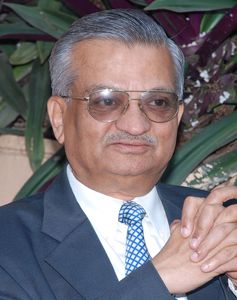World War II stopped Dr Homi J. Bhabha, the father of India’s nuclear programme, from returning to the UK and continuing his research there. So he stayed back in India and that became a turning point for Indian science, especially atomic energy. Though perhaps it was a golden era of Indian science, going by the pathbreaking contributions by the likes of C.V. Raman, S.N. Bose, Meghnad Saha, J.C. Bose and others, it was Bhabha, a cosmic ray physicist, who ushered in an era of mission mode programmes. He used his proximity with the Tata family and prime minister Jawaharlal Nehru to create an India-specific vision in atomic energy, space and electronics.
That was also the time when the development of nuclear weapons and a new geopolitics seemed to emerge. Bhabha ensured that the political leadership appreciated the ramifications of this emerging development from an Indian perspective, fully cognisant of the potential strengths of Indian scientific community. He did not want them to simply drift with the rest of the world.
While developments in China at that time did spark a debate on policy options for India, it was really the Bangladesh war that triggered the peaceful nuclear explosion experiment in May 1974. Underground nuclear explosions for peaceful applications were being pursued by some countries and discussed in conferences at the International Atomic Energy Agency. After India’s Peaceful Nuclear Explosion (PNE), however, the term and the related programmes disappeared from the scene. India came under an intense technology denial regime. The Americans discontinued the contracted fuel supplies to Tarapur, while the Canadians withdrew from the collaborative programme to build two PHWR (pressurised heavy-water reactor) units in Rajasthan.
Pokhran I was clearly well within India’s legal rights. The external technology denial regime disrupted and considerably delayed India’s nuclear power development, but it did not deter our self-reliant pursuit of a nuclear programme. On the other hand, it strengthened it. Today’s comprehensive nuclear capability of the country is clearly due to India’s autonomous pursuit of the programme against all odds.
Even as it went ahead with research on all dimensions of nuclear technology, India continued to advocate universal non-discriminatory nuclear disarmament. It wisely considered the non-proliferation treaty (NPT) as discriminatory and stayed away from it. However, the world moved towards perpetuating the discriminatory NPT quite in contrast with the expectation that was embedded within the treaty. Such external factors, including the deteriorating security situation around India, compelled Delhi towards exercising the nuclear weapons deployment option. The arrival of the final draft of the CTBT (Comprehensive Test Ban Treaty) was the final push for India to conduct the tests in May 1998 and emerge as a nuclear weapons state.
I was fortunate to be a part of both, the 1974 PNE and the 1998 weapons tests. I have experienced experts from advanced countries giving us unsolicited advice against pursuing nuclear reactor development or other complex nuclear technologies, citing our resource constraints. It was only after demonstrating superior Indian capability in relevant areas that such things stopped.
I remember an incident which happened during the preparations for the PNE. We used to take a jeep to our workplace, negotiating a long distance through the desert. One day, around half way through, the fan belt of the jeep gave way. The day’s work would have been lost had we waited for a replacement. We used fibres from nearby bushes to make a makeshift fan belt and negotiated the remaining distance. Seeing ropes being made in villages during my childhood came in handy.
The need for nuclear power to support India’s development was well recognised by Bhabha, including the need to harness India’s thorium resources―the largest in the world. He, therefore, designed a three-stage nuclear development programme, beginning with our modest uranium resources which have a small fissile component, progressively enlarging the fissile resource by converting fertile uranium and thorium in fast reactors and ending up with a large capacity thorium-based power production, commensurate with India’s energy needs. We mastered the PHWR technology for the first stage and fast breeder reactor technology for the second stage. While further reactor and fuel cycle technology development has to continue, accelerated large-scale deployment should be based on the technology already mastered. In parallel with the three-stage programme development, one could also advance thorium deployment, taking advantage of the larger PHWR capacity realisable now and the need to shrink spent-fuel inventory to reduce the backend fuel cycle cost.
Humanity is facing a much bigger existential threat today in the form of climate change. While there has been a right emphasis on accelerated renewable energy deployment and on ensuring a clean energy transition leading to global net zero emissions by the middle of this century, a large country like India would be forced to perpetuate its development deficit in the absence of large-scale nuclear power deployment. A developed India would need more than three and a half times the energy that renewable sources can produce. Hence, there is an urgent need to take up accelerated nuclear power deployment.
As France added 63 GWe between 1979 and 2000 and China added 43 GWe to 45 GWe between 2002 and 2019, India should be able to put in place a comparable or faster accelerated nuclear power deployment plan between now and 2070, our net zero deadline. This would at least alleviate the development deficit confronting us to some extent, if not bridge it. Timely action in this regard is crucial just as it was in the nuclear weapons case.
Kakodkar was chairman of Atomic Energy Commission and director of Bhabha Atomic Research Centre.



